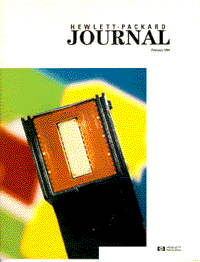|
 Although in many respects the HP DeskJet 1200C printer is an evolutionary step in the continued development and refinement of HP inkjet printing, it’s a big step, big enough to fill this entire issue with new and advanced inkjet technology.
Although in many respects the HP DeskJet 1200C printer is an evolutionary step in the continued development and refinement of HP inkjet printing, it’s a big step, big enough to fill this entire issue with new and advanced inkjet technology.
The objective for the Deskjet 1200C project seems modest enough to the uninitiated—develop a color printer that meets the needs of people who work in offices, even small ones. To the designers, that meant HP LaserJet print quality, LaserJet speed, LaserJet compatibility, lower-than-LaserJet cost for equivalent performance, a desktop form factor, plus industry-leading color quality and cost per copy on plain paper. The time-to-market goal was less than two years.
In the article on page 6, the two R&D section managers who led the development project outline the features of the new printer and sketch the approach taken to meet the project goals. Two key organiza-tional decisions were unusual. First, teams of engineers were formed to find the best ways to meet certain requirements without regard to whether their solutions would be implemented in the printer, the print cartridges, or the media. Three of the articles in this issue were written by members of these teams. The requirements they worked on were black text printing with laser quality and speed (page 9), color graphics quality (page 18), and print quality enhancement techniques (page 35). The second key decision was to obliterate the usual distinctions between design, manufacturing, and reliability engineering and make all of the team members development engineers, solely responsible for the design, producibility, and reliability of their parts. This decision is elaborated upon on page 65.
Among the contributions of the black text quality team (page 9) are the DeskJet 1200C’s print mode fore-caster, which previews the data to be printed and determines how best to print each swath, adjustment of the ink drop volume for each print mode, a new black ink, a high 8-kilohertz drop firing rate, a faster media-handling system, and a program to work with paper manufacturers on quality issues.
The color graphics quality team (page 18) chose a three-pass print mode for normal and high-quality printing on plain and special papers, and a six-pass mode for transparency and glossy polyester media. Color inks were developed with the goal of exceeding the gamut (range of colors) of other color printers. Polyester media design interacts with ink and printer design in complex ways and is treated in a separate article on page 28.
The print quality enhancement team (page 35) considered print modes, resolution enhancement tech-nology, cartridge alignment, and heating of the media. Three plain paper print modes are available to the DeskJet 1200C user: fast, normal, and high-quality. The modes differ mainly in the number of passes and the optical density of the black. Resolution enhancement technology selectively places or removes dots to improve the smoothness of text characters.
Unlike previous HP inkjet printers, the DeskJet 1200C has four print cartridges, one for black ink and one each for the three primary colors: cyan, magenta, and yellow. The basic design for these four cartridges and three similar cartridges for the HP DesignJet 650C large-format drafting plotter was known as the “platform” (see page 46). It’s an entirely new design that features a large ink capacity, an ink level indi-cator, and precise machining so that the four cartridges align accurately without adjustment. The print-head, which is the part of the cartridge that contains the nozzles and the ink-drop firing mechanism, is also a new design (see page 41). The NMOS driver circuits are right on the printhead—a challenge be-cause the printhead is immersed in ink. The printhead has 104 nozzles—more than previous designs— but has fewer interconnections and costs less. It’s also capable of a higher firing rate. Selected topics on print cartridge manufacturing are treated in the article on page 79.
The architecture of the HP DeskJet 1200C printer—the basic mechanical, electrical, and firmware design—is discussed in the article on page 55. The heated media path, which features new drive roller and stepper motor designs, media flattening devices, and precise gearing, is the subject of the article on page 72. Maintenance of the print cartridges within the printer, which encompasses the functions of capping, wiping, and priming the cartridges, is described in the article on page 67.
The article on page 85 addresses something called the DeskJet 1200C’s “connectivity”, a collective term for the software and firmware components of the printer. Topics discussed in this article are the PCL 5C language including a feature called raster operations which provides advanced drawing func-tionality, the language interface to the mechanical firmware which can automatically switch between the PCL 5C and PostScriptE languages depending on the type of file sent to the printer, and a screen calibration tool which lets the user make adjustments so that the printed colors match those seen on the monitor screen.
R.P. Dolan
Editor
|
|